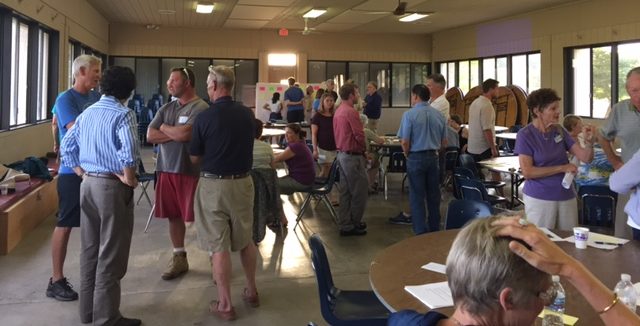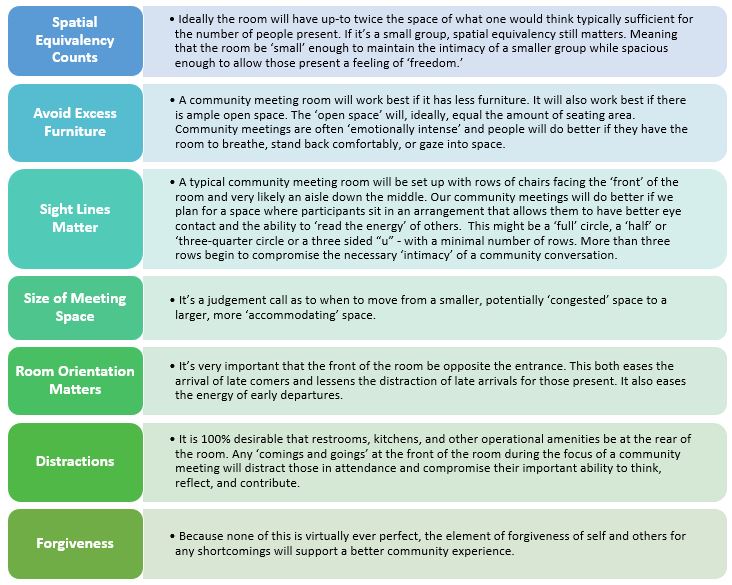
July 16, 2019
By Bert Stitt, Emissary, Bert Stitt & Associates
Engaging the public on the issues facing Lake Michigan’s coastal bluffs can be as important as understanding why and how coastal processes such as erosion and flooding impact Lake Michigan’s shorelines. Public engagement increases a community’s capacity to address local impacts of changing lake levels, wave action, and shoreline development by enhancing community knowledge and improving coastal management practices.
Bert Stitt, owner of Bert Stitt & Associates, has over 30 years of experience teaching communities to cope with complex development processes so they can take charge of their culture, vision, and change. Among the services he provides to communities are facilitation and strategic planning and visioning. In fact, you may have met Bert as he facilitated the community conversations at the end of our Coastal Resilience Boat Tours.
We asked Bert to share his thoughts on the ‘art and commitment of public engagement.’ In this blog post, he describes the importance of establishing a shared community vision and voice, what it takes to establish a shared community vision, and considerations for hosting an effective community meeting.
Part 1: A Lake Michigan Coastal Walking Meditation
All one has to do is take a thoughtful walk along our Lake Michigan coastlines at any time of year and along just about any stretch to see that our stewardship of that magnificent meeting of land and water must remain constant and skillful.
The evidence of erosion; from homes precariously perched at the bluff edges to some gargantuan cement efforts at the shoreline to create/protect beaches for personal/institutional/business purposes adds up to a host of land and water compromises that we, as citizens of the earth and our individual communities, have a moral obligation to address with all the skill, muscle and grace we can muster.
We are called to establish a shared appreciation for the stewardship of our lands and waters as a matter of the confluence of habit, habitat, investment, and the effective application of best practices in community engagement. As we practice meaningful collaboration with shared understanding and intention we can find a better response to our coastal waters and landscape and the human condition.
What are some of these best practices? Let’s start with full-public engagement in the benchmark conversations of scientific research, property rights, and community collaboration to establish trust and open conversation, with thoughtful and dedicated effort.
When we find we can establish a fully SHARED VISION of a desirable future we are positioned to navigate the many and varied options going forward. To do that it is very useful to walk and re-walk that coastline, alone and with others to fully engage its realities and allow all of its voices to speak. It’s that shared vision and voice that will carry us forward and provide future generations with something better than is otherwise thought possible.
Part 2: What does it take to establish a ‘Shared’ Community Vision?
It’s fair to say that it takes guts, determination, wisdom, generosity, patience, skillful organization, and numerous other talents that don’t always come naturally. It’s also fair to say that it requires commitment to robust follow-through of time and money. One might do well to think in terms of months rather than weeks – possibly years.
I hasten to add that, while it takes all of those things, the lack of any, or all of them, must not pre-determine the intention or the will to move forward in the theater* of community visioning. Visioning can happen at multiple layers of perspective, skill, effectiveness, involvement, and ultimate value. It’s better to do something and risk ‘failure’ than to do nothing at all! It might even require starting with the intention to create a vision-of-a-visioning process. This might be called backing up until we can see the landscape of the visioning process.
While failure in community visioning can and does happen….regularly…it’s no reason to give up. Never doubt that many successful projects have been built on the ashes of previous efforts. And, that’s especially true in ‘community’ projects. If you don’t try and fail, future efforts will not have the benefit of your learnings and experiences. While failure isn’t necessarily pretty the first or even second, or third, time around, I have witnessed astoundingly beautiful results in the passage of time, built on the rocks of failure.
Community visioning, and especially the beginning realizations of that vision, can take as much as two years or better. Here is an outline of the steps:
-
-
- A desire, even yearning, for something better
- An exhaustion with what has not happened!
- An acknowledgement that something must happen!
- Preliminary organizing, i.e. finding a core set of willing and inspired ‘worker bees’ to shoulder the effort
- Be sure to welcome all who are willing to commit to the time and effort involvement.
- Be sure to forgive all those who fall out due to fatigue, boredom, losing interest or any other human condition.
- It works better when the group represents the various elements of the community in: influence, skill, access to others, commitment, desire, wealth, poverty, accomplishments (great and small), ethnicity, roots.
- It takes a commitment to each other and to the work. And, it requires forgiveness when we under-produce, do poorly or even fail, as individuals or as a group.
- It also requires celebration of even the smallest successes!
-
*Theater – As in the military sense of ‘moving on multiple fronts: ‘Land, Sea and air’ / as in the community sense of ‘moving on multiple fronts: Residents, Local Government, Institutions, Manufacturers, Retailers, Professionals, the Arts and any other Community Energy.
Part 3: The Community Meeting Space
Walking into a community meeting is an experience with many facets: We greet friends, neighbors, and associates as we find ourselves mixing and mingling and approaching a seat with a certain anticipation, uncertainty, hope; not sure what we should be expecting. It’s an exercise in wonderment and anticipation or apprehension, even dread? The dynamics are many: convivial greetings, silent sitting, low voices, preemptive declarations about what should and should not be, protestations … it’s a long list. Anything can happen!
Oftentimes we can underestimate the importance of the actual meeting space to the success of our meetings. Seldom do those involved (our resident neighbors, business people, local government officials/staff, visitors and others) have the skill to understand the ideal physicality of a ‘community’ meeting room: How big is the room? How is it set up? Where is it located? Below are some simple tips for setting up a community meeting space to encourage a productive conversation.
Simple Tips for Setting Up Community Meeting Space







